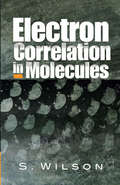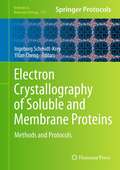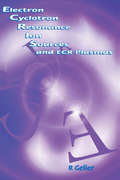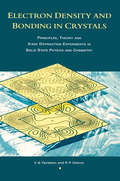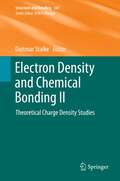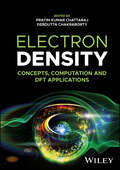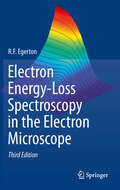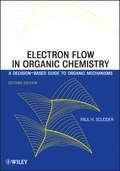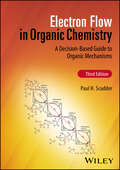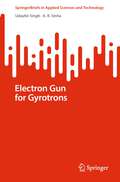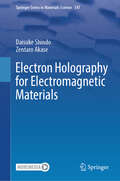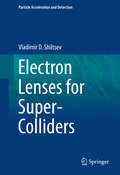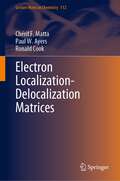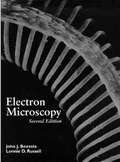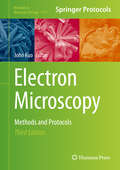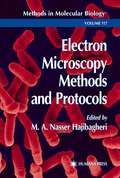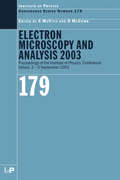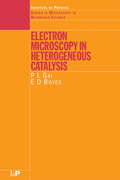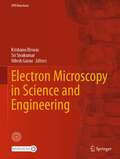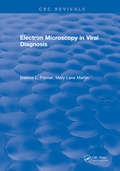- Table View
- List View
Electron Correlation in Molecules
by S. WilsonElectron correlation effects are of vital significance to the calculation of potential energy curves and surfaces, the study of molecular excitation processes, and in the theory of electron-molecule scattering. This text describes methods for addressing one of theoretical chemistry's central problems, the study of electron correlation effects in molecules.Although the energy associated with electron correlation is a small fraction of the total energy of an atom or molecule, it is of the same order of magnitude as most energies of chemical interest. If the solution of quantum mechanical equations from first principles is to provide an accurate quantitative prediction, reliable techniques for the theoretical determination of the effect of electron correlation on molecular properties are therefore important. To that end, this text explores molecular electronic structure, independent electron models, electron correlation, the linked diagram theorem, group theoretical aspects, the algebraic approximation, and truncation of expansions for expectation values.
Electron Crystallography of Soluble and Membrane Proteins
by Ingeborg Schmidt-Krey Yifan ChengThe basic principle of electron crystallography is to calculate a 3D density map by combining the amplitudes obtained from electron diffraction patterns with the experimental phases calculated from images of two-dimensional crystals of membrane or soluble proteins. This technology is very well developed and has produced a number of atomic models of membrane proteins in a lipid environment. Focused on comprehensive experimental protocols, Electron Crystallography of Soluble and Membrane Proteins: Methods and Protocols covers the entire range of techniques used in electron crystallography, including protein sample preparation, 2D crystallization, and screening in negative stain over electron cryo-microscopy (cryo-EM) and data processing, as well as modeling of conformational changes. Additional chapters provide perspective on past, present, and future challenges as well as complementary methods. Written for the popular Methods in Molecular BiologyTM series, the work contains the kind of detailed descriptions and implementation advice necessary to ensure successful results. Comprehensive and cutting-edge, Electron Crystallography of Soluble and Membrane Proteins: Methods and Protocols serves laboratories new to the methods as well as state-of-the-art facilities pursuing this exciting area of protein science.
Electron Cyclotron Resonance Ion Sources and ECR Plasmas
by R GellerAcknowledged as the "founding father" of and world renowned expert on electron cyclotron resonance sources Richard Geller has produced a unique book devoted to the physics and technicalities of electron cyclotron resonance sources. Electron Cyclotron Resonance Ion Sources and ECR Plasmas provides a primer on electron cyclotron phenomena in ion sour
Electron Density and Bonding in Crystals: Principles, Theory and X-ray Diffraction Experiments in Solid State Physics and Chemistry
by V.G Tsirelson R.P OzerovElectron Density and Bonding in Crystals: Principles, Theory and X-Ray Diffraction Experiments in Solid State Physics and Chemistry provides a comprehensive, unified account of the use of diffraction techniques to determine the distribution of electrons in crystals. The book discusses theoretical and practical techniques, the application of electron density studies to chemical bonding, and the determination of the physical properties of condensed matter.The book features the authors' own key contributions to the subject as well a thorough, critical summary of the extensive literature on electron density and bonding. Logically organized, coverage ranges from the theoretical and experimental basis of electron density determination to its impact on investigations of the nature of the chemical bond and its uses in determining electromagnetic and optical properties of crystals. The main text is supplemented by appendices that provide clear, concise guidance on aspects such as systems of units, quantum theory of atomic vibrations, atomic orbitals, and creation and annihilation operators. The result is a valuable compendium of modern knowledge on electron density distributions, making this reference a standard for crystallographers, condensed matter physicists, theoretical chemists, and materials scientists.
Electron Density and Chemical Bonding I
by Dietmar StalkeD. Stalke, U. Flierler: More than Just Distances from Electron Density Studies.- A.O. Madsen: Modeling and Analysis of Hydrogen Atoms.- B.B. Iversen/J. Overgaard: Charge Density Methods in Hydrogen Bond Studies.- U. Flierler, D. Stalke: Some Main Group Chemical Perceptions in the Light of Experimental Charge Density Investigations.- D. Leusser: Electronic Structure and Chemical Properties of Lithium Organics Seen Through the Glasses of Charge Density.- L. J. Farrugia, P. Macchi: Bond Orders in Metal-Metal Interactions Through Electron Density Analysis.- W. Scherer, V. Herz, Ch. Hauf: On the Nature of β-Agostic Interactions: A Comparison Between the Molecular Orbital and Charge Density Picture.
Electron Density: Concepts, Computation and DFT Applications
by Pratim Kumar Chattaraj Debdutta ChakrabortyDiscover theoretical, methodological, and applied perspectives on electron density studies and density functional theory Electron density or the single particle density is a 3D function even for a many-electron system. Electron density contains all information regarding the ground state and also about some excited states of an atom or a molecule. All the properties can be written as functionals of electron density, and the energy attains its minimum value for the true density. It has been used as the basis for a quantum chemical computational method called Density Functional Theory, or DFT, which can be used to determine various properties of molecules. DFT brings out a drastic reduction in computational cost due to its reduced dimensionality. Thus, DFT is considered to be the workhorse for modern computational chemistry, physics as well as materials science. Electron Density: Concepts, Computation and DFT Applications offers an introduction to the foundations and applications of electron density studies and analysis. Beginning with an overview of major methodological and conceptual issues in electron density, it analyzes DFT and its major successful applications. The result is a state-of-the-art reference for a vital tool in a range of experimental sciences. Readers will also find: A balance of fundamentals and applications to facilitate use by both theoretical and computational scientists Detailed discussion of topics including the Levy-Perdew-Sahni equation, the Kohn Sham Inversion problem, and more Analysis of DFT applications including the determination of structural, magnetic, and electronic properties Electron Density: Concepts, Computation and DFT Applications is ideal for academic researchers in quantum, theoretical, and computational chemistry and physics.
Electron Diffraction in the Transmission Electron Microscope: Electron Diffraction in the Transmission Electron Microscope
by P.E. ChampnessThis book is a practical guide to electron diffraction in the transmission electron microscope (TEM). Case studies and examples are used to provide an invaluable introduction to the subject for those new to the technique. The book explains the basic methods used to obtain diffraction patterns with the TEM. The numerous illustrations aid the understanding of the conclusions reached.
Electron Energy Loss Spectroscopy (Microscopy Handbooks)
by R. BrydsonElectron Energy Loss Spectroscopy (EELS) is a high resolution technique used for the analysis of thin samples of material. The technique is used in many modern transmission electron microscopes to characterise materials. This book provides an up-to-date introduction to the principles and applications of EELS. Specific topics covered include, theory of EELS, elemental quantification, EELS fine structure, EELS imaging and advanced techniques.
Electron Energy-Loss Spectroscopy in the Electron Microscope
by R. F. EgertonWithin the last 30 years, electron energy-loss spectroscopy (EELS) has become a standard analytical technique used in the transmission electron microscope to extract chemical and structural information down to the atomic level. In two previous editions, Electron Energy-Loss Spectroscopy in the Electron Microscope has become the standard reference guide to the instrumentation, physics and procedures involved, and the kind of results obtainable. Within the last few years, the commercial availability of lens-aberration correctors and electron-beam monochromators has further increased the spatial and energy resolution of EELS. This thoroughly updated and revised Third Edition incorporates these new developments, as well as advances in electron-scattering theory, spectral and image processing, and recent applications in fields such as nanotechnology. The appendices now contain a listing of inelastic mean free paths and a description of more than 20 MATLAB programs for calculating EELS data.
Electron Flow in Organic Chemistry
by Paul H. ScudderSets forth the analytical tools needed to solve key problems in organic chemistryWith its acclaimed decision-based approach, Electron Flow in Organic Chemistry enables readers to develop the essential critical thinking skills needed to analyze and solve problems in organic chemistry, from the simple to complex. The author breaks down common mechanistic organic processes into their basic units to explain the core electron flow pathways that underlie these processes. Moreover, the text stresses the use of analytical tools such as flow charts, correlation matrices, and energy surfaces to enable readers new to organic chemistry to grasp the fundamentals at a much deeper level.This Second Edition of Electron Flow in Organic Chemistry has been thoroughly revised, reorganized, and streamlined in response to feedback from both students and instructors. Readers will find more flowcharts, correlation matrices, and algorithms that illustrate key decision-making processes step by step. There are new examples from the field of biochemistry, making the text more relevant to a broader range of readers in chemistry, biology, and medicine. This edition also offers three new chapters:Proton transfer and the principles of stabilityImportant reaction archetypesQualitative molecular orbital theory and pericyclic reactionsThe text's appendix features a variety of helpful tools, including a general bibliography, quick-reference charts and tables, pathway summaries, and a major decisions guide.With its emphasis on logical processes rather than memorization to solve mechanistic problems, this text gives readers a solid foundation to approach and solve any problem in organic chemistry.
Electron Flow in Organic Chemistry: A Decision-Based Guide to Organic Mechanisms
by Paul H. ScudderElectron Flow in Organic Chemistry Teaches students to solve problems in Organic Chemistry using methods of analysis that are valuable and portable to other fields Electron Flow in Organic Chemistry provides a unique decision-based approach that develops a chemical intuition based on a crosschecked analysis process. Assuming only a general background in chemistry, this acclaimed textbook teaches students how to write reasonable reaction mechanisms and use analytical tools to solve both simple and complex problems in organic chemistry. As in previous editions, the author breaks down challenging organic mechanisms into a limited number of core elemental mechanistic processes, the electron flow pathways, to explain all organic reactions—using flow charts as decision maps, energy surfaces as problem space maps, and correlation matrices to display all possible interactions. The third edition features entirely new chapters on crosschecking chemical reactions through good mechanistic thinking and solving spectral analysis problems using organic structure elucidation strategies. This edition also includes more biochemical reaction mechanism examples, additional exercises with answers, expanded discussion of how general chemistry concepts can show that structure determines reactivity, and new appendix covering transition metal organometallics. Emphasizing critical thinking rather than memorization to solve mechanistic problems, this popular textbook: Features new and expanded material throughout, including more flowcharts, correlation matrices, energy surfaces, and algorithms that illustrate key decision-making processes Provides examples from the field of biochemistry of relevance to students in chemistry, biology, and medicine Incorporates principles from computer science and artificial intelligence to teach decision-making processes Contains a general bibliography, quick-reference charts and tables, pathway summaries, a major decisions guide, and other helpful tools Offers material for instructors including a solutions manual, supplemental exercises with detailed answers for each chapter usable as an exam file, and additional online resources Electron Flow in Organic Chemistry: A Decision-Based Guide to Organic Mechanisms, Third Edition, is the perfect primary textbook for advanced undergraduate or beginning graduate courses in organic reaction mechanisms, and an excellent supplement for graduate courses in physical organic chemistry, enzymatic reaction mechanisms, and biochemistry.
Electron Gun for Gyrotrons (SpringerBriefs in Applied Sciences and Technology)
by Udaybir Singh A. K. SinhaThis book highlights the emission, transmission, and launching of an electron beam. It presents an overview and recent advances in order to enhance knowledge in the field of gyrotron in general and electron gun in particular. The book is presented in seven chapters starting with the introduction and ending with future possible directions in the field of electron beams and gyrotrons.
Electron Holography for Electromagnetic Materials (Springer Series in Materials Science #347)
by Daisuke Shindo Zentaro AkaseThis book discusses the direct imaging of electric and magnetic fields of various functional materials using electron holography, providing indispensable information for understanding their electromagnetic properties. In order to clearly demonstrate the principles of this cutting-edge technology, easy-to-understand explanations are accompanied by numerous illustrations and figures throughout the book. The book highlights the dynamic nature of electromagnetic fields in novel materials, as revealed by changing temperature, or applying electric current and magnetic fields. Furthermore, it showcases, as a new development of the technique, the direct observation of accumulation and collective motion of electrons around charged insulators. Clear experimental data on electromagnetic fields and the motions of electrons help the reader understand their importance in materials science and fundamental physics. Seeing is believing!
Electron Lenses for Super-Colliders
by Vladimir D. ShiltsevThis book provides a comprehensive overview of the operating principles and technology of electron lenses in supercolliders. Electron lenses are a novel instrument for high energy particle accelerators, particularly for the energy-frontier superconducting hadron colliders, including the Tevatron, RHIC, LHC and future very large hadron colliders. After reviewing the issues surrounding beam dynamics in supercolliders, the book offers an introduction to the electron lens method and its application. Further chapters describe the technology behind the electron lenses which have recently been proposed, built and employed for compensation of beam-beam effects and for collimation of high-energy high-intensity beams, for compensation of space-charge effects and several other applications in accelerators. The book will be an invaluable resource for those involved in the design, construction and operation of the next generation of hadron colliders.
Electron Localization-Delocalization Matrices (Lecture Notes in Chemistry #112)
by Chérif F. Matta Ronald Cook Paul W. AyersThis book builds bridges between two yet separated branches of theoretical and mathematical chemistry: Chemical Graph Theory and Electronic Structure Calculations. Although either of the fields have developed their own techniques, problems, methods, and favorite benchmark cases independent from each other, the authors have managed to bring them together by using the localization-delocalization matrix (LDM). The LDM is a novel molecular descriptor that fingerprints a molecule by condensing the complicated electronic information in one, mathematically manageable, object. In this book, the authors introduce the readers to modeling techniques based on LDMs. Their technique offers a high accuracy as well as robust predictive power, often dramatically surpassing the potential of either of the constituting methods on their own. In addition to the comprehensive and accessible introduction to this new field of theoretical chemistry, the authors offer their self-developed software free to download, so that readers can try running their own simulations. The described methods are very general and can easily be implemented for calculating various properties and parameters such as mosquito repelling activity, ionic liquid properties, local aromaticity of ring molecules, log P's, pKa's, LD50, corrosion inhibition activities, and Lewis acidities and basicities – to only name a few. The free downloadable software helps readers automate the analysis of the matrices described in this book and hence facilitates application of the described methodology.
Electron Microscopy
by John J. Bozzola Lonnie D. RussellElectron Microscopy covers all of the important aspects of electron microscopy for biologists, including theory of scanning and transmission, specimen preparation, digital imaging and image analysis, laboratory safety and interpretation of images. The text also contains a complete atlas of ultrastructure. The text assumes minimal experience in physics and mathematics and is written so that readers will achieve a basic understanding of underlying principles so that these can be applied in a real laboratory setting.
Electron Microscopy
by John KuoThis book presents the newest technology in electron microscopy. It comprises two major areas of electron microscopy - transmission electron microscopy (TEM) and scanning electron microscopy (SEM). The volume provides clear, concise instructions on processing biological specimens and includes discussion on the underlying principles of the majority of the processes presented. A notes section enables efficient adaptation and troubleshooting of protocols.
Electron Microscopy Methods and Protocols
by M. A. HajibagheriHands-on experts describe in detail the key electron microscopy techniques used for examining cells, tissue, biological macromolecules, molecular structure, and their interactions. With emphasis on cryotechniques for quantitative biological X-ray microanalysis, the book also includes those methods that use antibodies to locate proteins within cells and that prepare and analyze nucleic acids, proteins, and protein-nucleic acid complexes. Numerous immunogold labeling techniques for precise ultrastructural localization, distribution, and quantitation of macromolecules in cryofixed or chemically-fixed cells are described in sufficient detail to provide practical insight into their advantages and limitations. Electron Microscopy Methods and Protocols offers both newcomers and established researchers across experimental biology and medicine wanting to expand their repertoire a gold-standard laboratory manual of cutting-edge electron microscopy techniques-each optimized for reproducibility and robust results-today's gold-standard laboratory manual.
Electron Microscopy and Analysis 1997, Proceedings of the Institute of Physics Electron Microscopy and Analysis Group Conference, University of Cambridge, 2-5 September 1997
by John M. RodenburgElectron Microscopy and Analysis 1997 celebrates the centenary anniversary of the discovery of the electron by J.J. Thomson in Cambridge and the fiftieth anniversary of this distinguished Institute group. The book includes papers on the early history of electron microscopy (from P. Hawkes), the development of the scanning electron microscope at Cambridge (from K. Smith), electron energy loss spectroscopy (from L.M. Brown), imaging methods (from J. Spence), and the future of electron microscopy (from C. Humphreys). Covering a wide range of applications of advanced techniques, it discusses electron imaging, electron energy-loss and x-ray analysis, and scanning probe and electron beam microscopies. This volume is a handy reference for professionals using microscopes in all areas of physics, materials science, metallurgy, and surface science to gain an overview of developments in our understanding of materials microstructure and of advances in microscope interrogation techniques.
Electron Microscopy and Analysis 2001 (Institute of Physics Conference Series)
by M Aindow C J KielyElectron microscopy is now a mainstay characterization tool for solid state physicists and chemists as well as materials scientists. Electron Microscopy and Analysis 2001 presents a useful snapshot of the latest developments in instrumentation, analysis techniques, and applications of electron and scanning probe microscopies. The book is ideal for
Electron Microscopy and Analysis 2003: Proceedings of the Institute of Physics Electron Microscopy and Analysis Group Conference, 3-5 September 2003
by David McComb Stephen MeVitieElectron microscopy is now a mainstay characterization tool for solid state physicists and chemists as well as materials scientists. Containing the proceedings from the Electron Microscopy and Analysis Group (EMAG) conference in September 2003, this volume covers current developments in the field, primarily in the UK. These conferences are biennial
Electron Microscopy in Heterogeneous Catalysis (Series in Microscopy in Materials Science)
by P.L Gai E.D BoyesCatalysis is one of the most important technologies in the industrial world, controlling more than 90% of industrial chemical processes and essential for large-scale production of plastics and fuel. Exploring the most common type of catalysis used in industry, Electron Microscopy in Heterogeneous Catalysis provides a coherent account of heterogeneo
Electron Microscopy in Science and Engineering (IITK Directions #6)
by Krishanu Biswas Sri Sivakumar Nilesh GuraoThis issue of Direction focuses on the rapid proliferation of electron microscopy (EM) for scientific as well as technological research. The content written by leading experts is intended to provide the capabilities of EM facilities, set at Indian Institute of Technology (IIT) Kanpur to solve various problems and caters to the needs of both internal and external users. The book provides a detailed and comprehensive viewpoint of the basic features and advanced capabilities of EM facilities to the scientific community. A large number of electron microscopes have been installed and utilized by researchers across various engineering and science departments; hence, this volume provides both breadth as well as depth of various EM facilities available at the institute.
Electron Microscopy in Viral Diagnosis
by Erskine L. PalmerThis text on electron microscopy in viral diagnosis is an invaluable reference investigators interested in the detection of viruses or viral subcomponents in liquid preparations or in thin sectioned cells. It contains an extensive collection of negative stain, thin section, and immunolabelled electron micrographs useful for reference viral diagnosis. The salient features of the replication of many virus families are presented in schematic form and all viruses now known to cause disease in humans, including the recently recognized human retroviruses, are described in separate chapter.
Electron Microscopy of Interfaces in Metals and Alloys
by L.M ClarebroughElectron Microscopy of Interfaces in Metals and Alloys examines the structure of interfaces in metals and alloys using transmission electron microscopy. The book presents quantitative methods of analysis and reviews the most significant work on interface structure over the last 20 years. It provides the first book description of the methods used for quantitative identification of Burgers vectors of interfacial dislocations, including the geometric analysis of periodicities in interface structure and the comparison of experimental and theoretical electron micrographs. The book explores low- and high-angle grain boundaries and interphase interfaces between neighboring grains, emphasizing interfacial dislocations and rigid-body displacements to the structure and properties of interfaces. It also analyzes the use of two-beam images and diffraction patterns for analysis and studies n-beam lattice imaging. The book includes numerous worked examples of the analysis of the structure of grain boundaries and interphase interfaces, which are particularly useful to those who need to consider the nature of intercrystalline interfaces.
